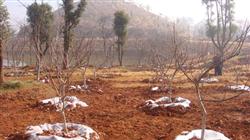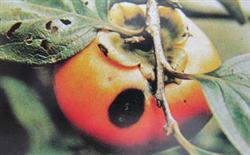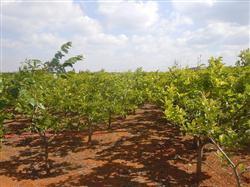How to plant sweet persimmons?

How to plant sweet persimmons? Sweet persimmon is one of the most treasured persimmons imported from Japan in China. There are more than ten varieties, such as Shinjiro, Fu, Izu, Nishimura and so on. It has high value of nutrition and health care, resistance to storage and transportation, good commerciality, and has excellent development prospects. This paper introduces its high-quality and high-yield cultivation techniques as follows: first, the establishment and planting of the garden chooses the sandy loam with a deep soil layer and a pH value of 5.5 Murray 7.5, which can be used in mountainous, flat and hilly land. Dig wide trenches of 100cm and deep 80cm or large holes of 100cmx100cmx80cm, apply rotten barnyard manure 50kg, add calcium superphosphate 5kg, potassium chloride 0.3kg as base fertilizer. The best planting period for sweet persimmon is from October to November. Generally, it is better to choose the improved varieties and strong seedlings grafted with wild persimmon No. 6 rootstock, with 120 plants per 667m2 and pollinated varieties according to the ratio of 12:1 between male and female plants. 2. Soil, fertilizer and water management in the stage of young trees, pay attention to loosening soil and weeding, and apply fertilizer properly, the first fertilizer is applied after spring shoot sprouting in one-year-old fixed planting garden, 10g urea is applied to the plant, 5kg is applied to human and animal manure, and then the amount of topdressing is gradually increased twice a month. In the second year, it can be fertilized once in March, May, August and September. The third young plant begins to hang fruit, and potassium fertilizer and a small amount of boron fertilizer should be applied. 4Mel-5 years sweet persimmon enters the high yield period, it is necessary to apply the "three fertilizers" well. That is to say, the first application of pre-flowering fertilizer was applied in 3murl-April, and the plant was applied with urea 100g, potassium sulfate 100g, phosphate fertilizer 50g, borax 5g and a small amount of multi-element microfertilizer; the second was strong fruit fertilizer, which was applied in 6mi-July, urea 100g, calcium superphosphate 150g, potassium sulfate 150g; and the third post-yield fertilizer, mainly organic fertilizer and phosphate fertilizer, to provide sufficient nutrients for high yield in the coming year. Persimmon root afraid of stagnant water, rainy season should pay attention to clear ditch drainage, strictly prevent stagnant water. However, it was drought before fruit expansion in September, so we should do a good job of watering drought resistance in time. Third, when shaping, pruning and planting, cut off the treetops at the height of 0.9mur1m. During the dormant period in winter or early spring, three branches with different directions and layers but with the same vertical and transverse distance were selected as the main branches, and the first main branch was 40--50cm from the ground. Cut off 20% of the shoot length of both the main branch and the non-main branch on the trunk. After 2 years of planting, cut off all the non-main branches in winter, cut off 20% of the growth of the main branches in the same year, and then cut off the thin, crossed and overlapping branches on the side branches. Finally, the robust branch extending on one side was selected as the first secondary branch at about 50cm away from the main branch, and 20% of the annual growth was cut off together with other remaining lateral branches. After 3 years of planting, the second main branch was selected according to the above method to form a dwarf natural happy crown. The main purpose of the pruning of adult trees is to cultivate strong fruiting mother branches on the main branches and secondary main branches. In winter, short fruiting branches and some thin and weak branches, retracted parts of overlong secondary main branches and old fruiting mother branches. Thick and short fruiting mother branches can also be cultivated by twisting, pulling, ring peeling and so on in summer. And take turns every year to replace the inner chamber of the tree in time to remove dense branches, overlapping branches, thin and weak branches, long branches, to ensure that the inner chamber is transparent. Fourth, flower and fruit management 1. Girdling at flowering stage: for trees with excessive vegetative growth, girdling 0.2--0.4cm on the main and secondary main branches at full bloom reached the width and depth of xylem to improve the fruit setting rate. two。 Artificial pollination: there are fewer male flowers in young sweet persimmon trees, and artificial pollination can increase the fruit setting rate by more than 35%. 3. Flower thinning and fruit thinning: for weak and multi-flowered trees, remove weak flowers and over-dense flowers at flowering stage, and small fruits and deformed fruits at young fruit stage. After the first physiological fruit drop in July, the healthy young fruit was selected according to the ratio of 25 leaves and one fruit, and the surplus fruit was removed. 4. Bagging to protect fruit: bagging can make the fruit smooth and uniform, prevent bird damage, sunburn and cracking, etc., so as to improve the rate of high quality and large fruit. Bagging is carried out after fruit thinning, spraying fungicide once before bagging, and then bagging with double-layer breathable paper bags. Unpack and color the fruit 15 days before ripening. 5. Pest control 1. Disease control: the main diseases of sweet persimmon are anthracnose, corner spot, gray mold and so on, which should be mainly prevented, disinfect seedlings before planting and clear the garden in winter. Anthracnose and angular spot disease can be sprayed with 70% methyl topiramate and 1000 times solution of Botrytis cinerea at the initial stage of the disease, and 4500 times solution of 50% Sukeling can be added to control gray mold. two。 Pest control: persimmon pedicel insects can be controlled in early May, 4% dimethrin powder 0.5kg can be applied under the canopy to kill the overwintering larvae, and the larvae can spray 3000 times of the fungicide EC at the initial stage of the larvae; diamondback moths can be sprayed with 2.5% deltamethrin 3000 times during the larval occurrence period; scale pests can be sprayed at 40% speed and 1000 times during the larval occurrence period. Click to get more persimmon planting techniques click to get more fruit planting techniques
- Prev

How to prevent and cure anthracnose of persimmon?
How to prevent and cure anthracnose of persimmon? Please introduce in detail that persimmon anthracnose is one of the main diseases harmful to persimmon trees. It is necessary to scientifically distinguish the symptom characteristics of the disease and understand the law of the disease, and take comprehensive measures to control it in time in order to achieve good results. 1. Symptom characteristics: the disease is mainly harmful to fruits, shoots and leaves.
- Next

How can sweet persimmon be planted with high yield?
How can sweet persimmon be planted with high yield? Please give guidance on the planting methods of sweet persimmon can be referred to as follows: first, the environment requires that the annual average temperature of sweet persimmon is 13: 18 ℃, the average temperature of fruit ripening period from June to August is 18: 19 ℃ (the altitude of Shilin county is 1600-1900m), and the sunshine hours from February to August are more than 1400 hours.
Related
- Moge, come on! The staff of the peasant association in the producing area of cantaloupe were frightened when the crowd gathered.
- Causes and Solutions of low Fruit setting rate of Apple
- Symptoms and control measures of passion fruit virus disease
- Fruit growing lesson: how do apple orchards keep high yields?
- Can you build orchards in the mountains? What are the pros and cons?
- How to manage the coloring period of Crisson grape?
- This paper introduces the processing technology of two kinds of fig products.
- How much is a month for retired teachers in rural areas by 2020?
- How can strawberry planting increase sugar content? We should pay attention to management in many aspects.
- What are the cultivation techniques on how to improve the yield of golden fruit?

